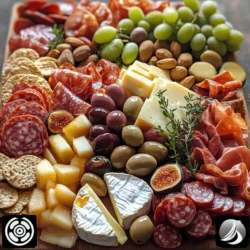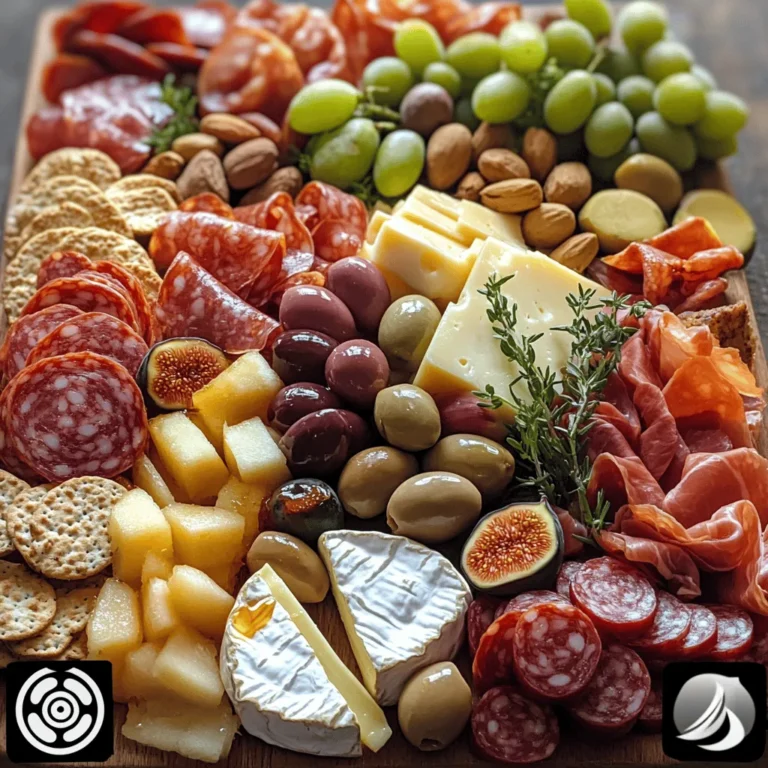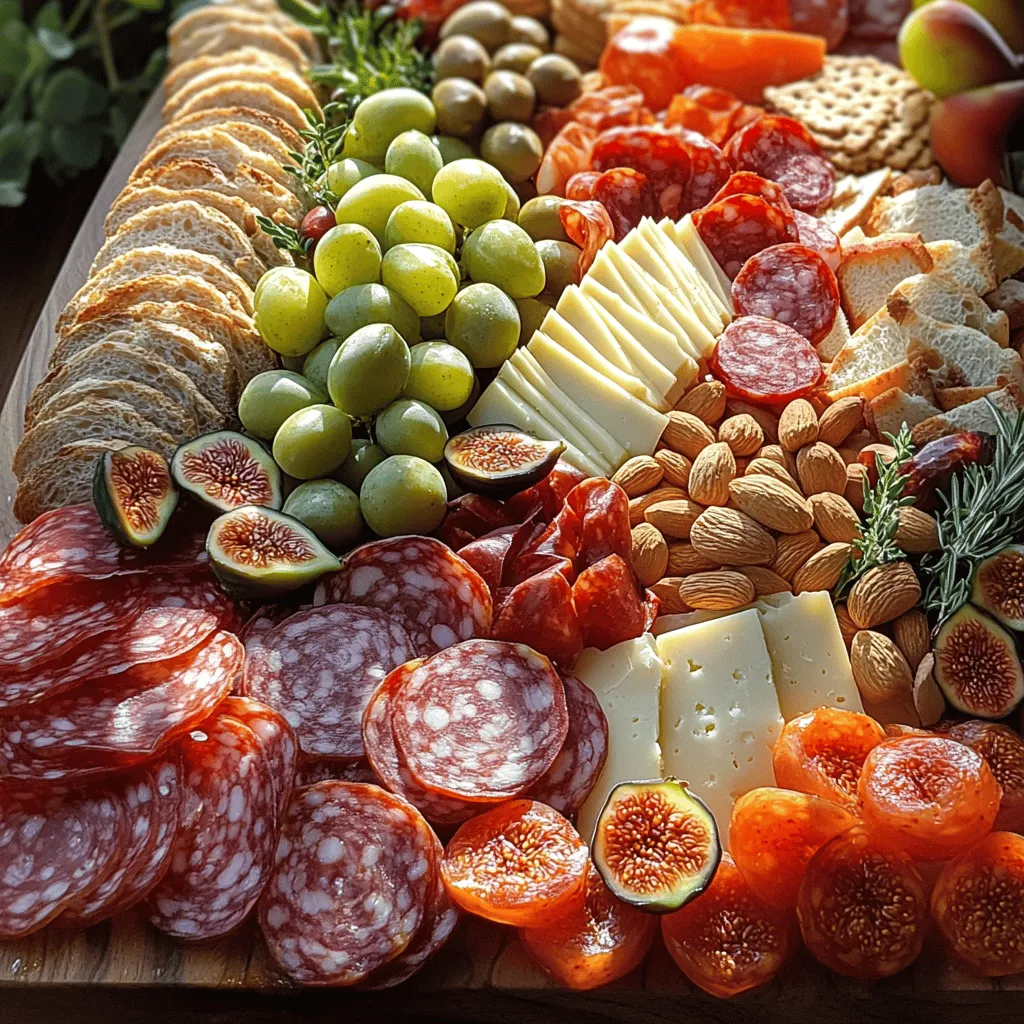Savory Snack Symphony: Easy Charcuterie Board
Creating a charcuterie board is an art that brings together an array of flavors, colors, and textures to entice the palate. The “Savory Snack Symphony” offers an easy and delightful way to assemble a charcuterie board that will impress guests at any gathering, whether it be a casual get-together or a festive celebration. This article will guide you through the process of creating a visually stunning and delicious charcuterie board, providing insights into ingredient selection, presentation tips, and the art of pairing.
Understanding the Charcuterie Board
To appreciate the charm of a charcuterie board, it’s essential to explore its origins and the evolution that has made it a staple in modern entertaining.
Exploring the Origin of Charcuterie
The term “charcuterie” originates from the French word for “cooked flesh.” Historically, charcuterie referred to a way of preserving meats, particularly pork, through methods like curing, smoking, and drying. This process was not only a means to prevent spoilage but also a way to enhance the flavors of the meat. Over the years, the concept of charcuterie has expanded beyond just meats to include a rich variety of accompaniments, transforming it into an art form that showcases an assortment of cured meats, cheeses, fruits, nuts, and breads.
In contemporary culinary trends, charcuterie boards have become a symbol of conviviality and creativity, often serving as the centerpiece for gatherings. Today, the term encompasses a wide range of boards featuring diverse ingredients, making it an appealing choice for those looking to impress their guests with minimal effort.
The Appeal of Charcuterie Boards
Charcuterie boards have surged in popularity due to their versatility and ease of preparation. They are perfect for various occasions, from intimate dinners to large celebrations. Guests can mingle and snack at their own pace, allowing for a more relaxed atmosphere. The visual appeal of a well-arranged board adds an element of sophistication, making it a feast for the eyes as well as the taste buds.
Moreover, charcuterie boards can cater to diverse dietary preferences, accommodating meat lovers, vegetarians, and those with gluten sensitivities by simply adjusting the ingredient selection. This adaptability makes them a go-to choice for hosts seeking to please a crowd, ensuring that everyone can enjoy a tasty bite.
Ingredients for Your Savory Snack Symphony
Creating the perfect charcuterie board involves selecting high-quality ingredients that complement each other. Here’s a breakdown of what to include in your “Savory Snack Symphony.”
Choosing Assorted Cured Meats
The foundation of any charcuterie board begins with an assortment of cured meats. Popular choices include salami, prosciutto, and chorizo. Each type of meat brings its own distinct flavor and texture, which can elevate the overall experience of the board.
When selecting your cured meats, consider the balance of flavors. For instance, the rich, salty profile of prosciutto pairs wonderfully with the robust spiciness of chorizo, while the tangy notes of salami add a contrasting taste. It’s essential to opt for quality over quantity; look for artisanal products or locally sourced options when possible. Slicing the meats thinly enhances their flavors and makes them easier for guests to enjoy.
Selecting a Variety of Cheeses
Next, select a diverse range of cheeses to accompany your meats. A well-rounded charcuterie board often includes a mixture of textures and flavors, which can be achieved by incorporating soft cheeses like brie, sharp varieties like aged cheddar, and pungent options like blue cheese.
Pairing cheese with meats and other ingredients is an art. For instance, the creaminess of brie complements the saltiness of prosciutto, while a sharp cheddar can provide a nice contrast to the spiciness of chorizo. Consider including a cheese knife or spreader on the board to encourage guests to sample different combinations.
Incorporating Mixed Olives
Olives are an excellent addition to your charcuterie board, offering bursts of flavor and enhancing the overall taste experience. There are many types of olives to choose from, including green olives, kalamata olives, and marinated varieties. Each type brings its own flavor profile, ranging from briny and tangy to sweet and fruity.
The role of olives extends beyond flavor; they also add an appealing visual element to the board. Their rich colors and varied shapes create an interesting contrast against the meats and cheeses. Including a small dish for olives can also help maintain cleanliness and make it easier for guests to serve themselves.
Adding Fresh Fruits for Contrast
Fresh fruits are essential for balancing the savory elements of your charcuterie board and adding visual appeal. Grapes, apple slices, and figs are popular choices that can provide a refreshing contrast to the rich flavors of meats and cheeses.
Fruits contribute sweetness and acidity, which can help cleanse the palate between bites. For example, the crispness of apple slices can cut through the richness of aged cheddar, while the sweetness of figs pairs beautifully with the saltiness of prosciutto. When arranging fruits, consider their colors and shapes to create a vibrant and inviting display.
Choosing Nuts for Crunch and Flavor
Incorporating nuts into your charcuterie board adds texture and flavor, making each bite more satisfying. Almonds, walnuts, and cashews are excellent options that bring a delightful crunch to the mix.
Nuts not only provide a nutritional boost but also enhance the overall flavor profile of the board. The creaminess of cheese pairs well with the crunch of nuts, creating a satisfying contrast. Consider offering a mix of raw and seasoned nuts to provide guests with different flavor experiences.
Bread and Crackers: The Foundation of the Board
Finally, no charcuterie board is complete without a selection of breads and crackers. These elements serve as the foundation upon which all other ingredients rest. Choose a variety of textures, such as crusty baguette slices, crispy crackers, and soft breadsticks, to cater to different preferences.
When selecting bread and crackers, consider their ability to complement the bold flavors of your meats and cheeses. A mild cracker can be a perfect vehicle for rich cheeses, while a hearty bread can stand up to the flavors of cured meats. Arrange these items around the perimeter of the board to frame the other ingredients and encourage guests to dig in.
As you embark on crafting your Savory Snack Symphony, remember that the beauty of a charcuterie board lies in its ability to reflect your personal taste and creativity. The next sections will delve deeper into presentation tips and the art of pairing, ensuring that your charcuterie board is not only delicious but a feast for the eyes.
Types of Bread and Crackers to Consider
When assembling your charcuterie board, the choice of bread and crackers is crucial. They serve as the foundation for your delicious toppings and can enhance the overall flavor profile of your board. Here are some popular options to consider:
Baguette Slices
Baguette slices are a classic choice for charcuterie boards. Their crusty exterior and soft, airy interior provide the perfect base for cheeses and spreads. To prepare, slice a fresh baguette into ½-inch thick rounds and arrange them artfully on the board. You can also toast the slices lightly in the oven to add an extra crunch.
Breadsticks
Breadsticks are another excellent option, offering a delightful crunch and a convenient way to scoop up dips and spreads. Opt for traditional Italian breadsticks or flavored varieties, such as rosemary or garlic, to add an aromatic touch. Place them in a small mason jar or stand them upright in a glass for an appealing presentation.
Crackers
Include a variety of crackers to cater to different tastes. Choose a mix of textures—some crisp and crunchy, others softer and more delicate. Look for options like whole grain crackers, water crackers, or herbed crackers. Arrange them in small groups to encourage guests to sample different combinations.
Crafting Your Charcuterie Board
Selecting the Perfect Board
The board you choose plays a significant role in the presentation of your charcuterie spread. Here are some tips for selecting the right one:
Ideal Materials and Sizes for Charcuterie Boards
Charcuterie boards come in various materials, including wood, slate, and marble. Wooden boards are popular for their rustic charm, while slate and marble boards lend a modern touch. Choose a board that is large enough to hold all your ingredients comfortably, typically around 18 to 24 inches in length. This size allows for ample space to arrange your cheeses, meats, and accompaniments without overcrowding.
How to Choose a Board that Complements Your Theme
Consider the theme of your gathering when selecting a board. For a casual family get-together, a natural wood board may be perfect. For an elegant soirée, a sleek marble board may enhance the sophisticated atmosphere. Additionally, think about the colors of your ingredients—dark boards can make vibrant fruits and cheeses pop, while light boards create a soft, inviting look.
Arranging the Cheeses Beautifully
The cheese selection is often the star of the show on a charcuterie board. To maximize visual appeal, follow these techniques for cutting and placing your cheeses:
Techniques for Cutting and Placing Cheeses for Visual Impact
Cut cheeses into a variety of shapes—cubes, wedges, and slices—to create an interesting visual dynamic. Place larger pieces of cheese towards the back or center of the board, gradually working your way to smaller pieces on the sides. Use cheese markers to label each type, especially if you have a range of flavors. This not only looks appealing but also helps guests identify their favorites.
Tips on Varying Cheese Shapes and Textures
Incorporate a mix of textures by choosing soft, hard, and crumbly cheeses. For example, pair creamy Brie with a sharp aged cheddar and a crumbly blue cheese. This variety will not only enhance the flavor experience but also provide a delightful contrast in textures. Consider including at least three to five different types of cheese to give your board depth and character.
Artfully Presenting the Cured Meats
Cured meats add a savory element to your charcuterie board. Here’s how to present them elegantly:
Creative Ways to Fold and Stack Meats for Aesthetics
Fold slices of prosciutto, salami, or chorizo into quarters and arrange them in small groups. You can also create small rosettes by rolling and securing them with toothpicks. Stack the meats in a way that allows for easy access while maintaining a visually appealing layout. Place meats near complementary cheeses to encourage guests to mix and match.
Balancing Meat Placement with Cheese and Other Ingredients
Ensure that the placement of meats balances well with the cheeses and other accompaniments. Avoid clustering all the meats in one area; instead, distribute them evenly across the board to create a harmonious look. This will not only enhance the aesthetics but also make it easier for guests to serve themselves.
Incorporating Fruits, Olives, and Nuts
Adding fruits, olives, and nuts brings a burst of color and flavor to your charcuterie board. Here’s how to incorporate them effectively:
Strategies for Scattering and Grouping These Ingredients
Scatter fresh fruits like grapes, sliced apples, or figs around the cheeses and meats. These sweet elements contrast beautifully with savory ingredients. Place olives in small bowls or group them together to create a visually appealing cluster. Nuts, such as almonds or walnuts, can be sprinkled around the board or placed in small piles to add texture and crunch.
Importance of Color Balance and Visual Harmony
Aim for a balanced color palette by mixing vibrant fruits with earthy nuts and rich meats. This will make your charcuterie board visually stunning and inviting. Remember that the presentation is just as important as the taste, so take your time to arrange each ingredient thoughtfully.
Final Touches: Drizzling and Garnishing
The finishing touches can elevate your charcuterie board from ordinary to extraordinary. Here are some ideas:
Ways to Incorporate Honey or Fig Jam for Sweetness
Drizzle honey over cheese or place a small dish of fig jam on the board. These sweet additions complement the savory elements and provide a delightful contrast. Consider pairing honey with goat cheese or figs with sharp cheddar—these combinations are sure to impress your guests.
The Role of Fresh Herbs in Enhancing Flavor and Presentation
Fresh herbs such as rosemary, thyme, or basil can enhance both the flavor and the presentation of your board. Scatter a few sprigs around the ingredients for a pop of green and a fragrant aroma. Not only do they add a fresh touch, but they also invite guests to explore different flavor combinations.
Serving Suggestions
How to Serve Your Charcuterie Board
Presentation matters, and serving your charcuterie board correctly ensures that guests have a delightful experience.
The Best Utensils and Serving Methods for a Charcuterie Board
Provide small cheese knives or spreaders for guests to serve themselves. Make sure to include spoons for any dips or spreads and small forks for picking up olives or fruits. If you have a large gathering, consider providing extra serving utensils to make it easier for guests to access different areas of the board.
Ideas for Pairing Wines or Beverages with Your Board
A well-curated charcuterie board pairs beautifully with a variety of beverages. Consider serving a light white wine, such as Sauvignon Blanc, which complements the cheeses, or a bold red like Merlot, which pairs well with cured meats. For non-alcoholic options, sparkling water with a splash of citrus can cleanse the palate and enhance the flavors of the board.
Creating a Memorable Experience for Guests
Engaging your guests can enhance their experience with your charcuterie board.
Tips for Engaging Guests with the Board
Encourage guests to create their own combinations by providing a variety of ingredients. You might even invite them to share their favorite pairings or recommend their favorite cheese. This interaction not only makes the experience more enjoyable but also fosters a sense of community and sharing.
How to Encourage Experimentation with Flavors
Encourage guests to mix and match different cheeses, meats, and accompaniments. You can suggest specific pairings or leave it open-ended for them to discover their favorites. This exploration can lead to delightful surprises and conversations about flavor profiles, making your charcuterie board an engaging centerpiece.
Conclusion
The Savory Snack Symphony charcuterie board is not just a meal but a sensory experience that brings people together. By thoughtfully selecting ingredients and artfully arranging them, you can create a beautiful and delicious spread that will be the highlight of any gathering. This guide not only equips you with the knowledge to assemble a charcuterie board but also invites you to explore the delightful world of flavors, textures, and colors in your culinary adventures. Whether for a family gathering or a festive occasion, your charcuterie board will surely leave a lasting impression. So gather your favorite ingredients, unleash your creativity, and enjoy the art of charcuterie!



